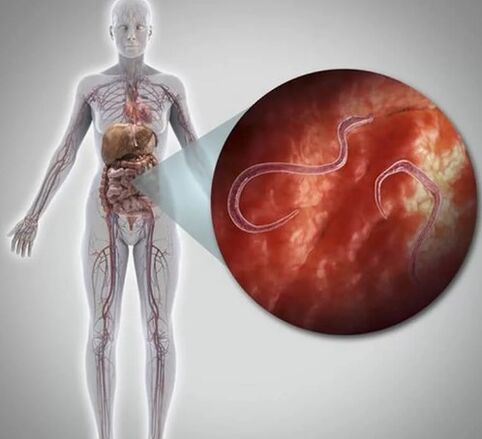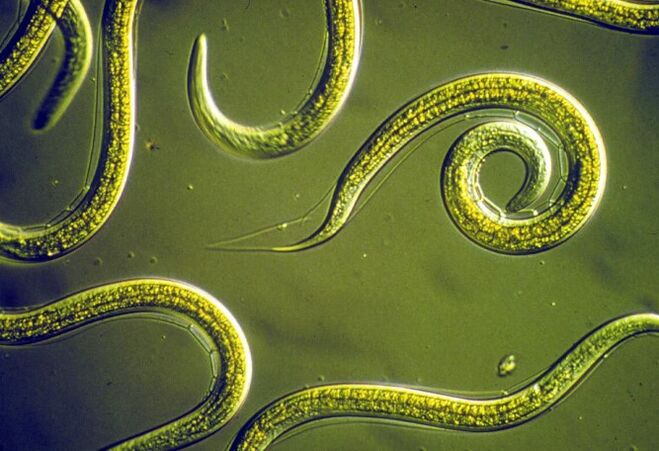Human parasites are parasites, infections that are subject to a person. The general definition of the word "parasite" does not only apply to multicellular and protozoa, living at the expense of its owners and affecting the last, but also viruses, bacteria and mushrooms of the same quality. According to the historical tradition, and from the point of view of medical parasitology, it is common to call any beings leading the parasite lifestyle, except for viruses and bacteria of the same quality.

Parasites include many helminths, fungi, viruses, protozoa, worms, crustaceans, spiders -shaped, insects. The owner of the parasite can be bacteria, the simplest, growing -growth, animals and humans. Parasites undergo complex developmental cycles: sometimes they require a change of 2-3 owners whose body is mid (helminths passing larvae levels) or end (helminths becomes invasive).
From history:
The study of parasites among ancient people was based on the studies of stools and other petrated materials. The earliest parasites found in humans are the Westured Paragonimus eggs of North Chile, which are found in hard stools, and are about 5900 BC. e. In Brazil, worm eggs from 5000 cm are also found. e. , in Peru - nematod eggs from 2330 BC. e. And Egyptian mummies since 2000, 1250, and 1000 years. Bc. e. They contain solitary eggs, together with good female worms.
In Berlin, for the period 1866-1875. 16% of all the bodies opened contain worms. Bull taper (Taenighynchus saginatus) is very widespread in which raw beef is eaten. In St. Petersburg, according to Kessler, 3. Tekenian pigs (Taenia Solium) are found anywhere in areas where they eat raw or partial pork. In St. Petersburg in the late 19th century, about 3 % of the population experienced this parasite. When they begin to avoid the use of raw meat, the percentage of diseases decreased, for example, in Denmark from 53 % to 20 % for 10-12 years. Dypilidium caninum lives in the intestines of dogs and cats, and rarely in children's intestines. Child infections in the late 19th century are known from England, Germany, Denmark: Infections occur exclusively when lice are swallowed.
Parasites and their release(products in their lives) are the most powerful poison for the human body. They cause severe acidity and thickening of blood and the entire internal environment. They cause the most serious health disorders. From bronchitis to oncology. Destroy one's soul, deprive peace and sleep. In the body of children, parasites inhibit the normal development of the child's nervous system and, with long disease, contribute to mental and physical decline.
Classification
By distribution:

- Ubiquette - meet anywhere.
- Tropical - distributed in the tropical climate zone.
About biological and epidemiological features:
- Geohelminths are a disease in which helminths begins to develop in the human body, and then on non -living substrates, more often on earth.
- Biohelminths are a disease in which the biological cycle of helminth development must occur in the body of another living beings, except for a person. Distinguishing between the final owners, in the body where helminths develops to a mature, and middle sexual stage, where the parasite is at the larvae or its reproduction is not sexually transmitted. Someone is more often the final owner, less often - the middle.
- Contacting helminthiasis is a disease in which parasites are distinguished from the human body that are mature or almost mature, as a result of other possible infections or re -infection (auto aggression, recurrence).
Depending on the localization of parasites in the body:
- Enlightenment - staying in the intestinal cavity and other cavities (for example, ascarides, ribbons).
- Fabric - live in fabric (systematis, ehinokokkoz).
In the home of the owner:
- External: mosquitoes, blinds, leeches, fleas.
- Internal(Helminthias):Round worms(Nematodes - ascarids, filaria, vlasov, pinworms, strungyloids, Ancylostomidae, Trichinella);A flat worm:
- Trematodes (plates - paint bikelter (opisthorchis), cloner, fasciola, schistosomes);
- Cestodes (Ribbon Worms - Bull and Pork Tapeworm, Dwarf tanning, broad tape, echinococcus).
- Bacteriosis(Leptospira, Staphylococcus, Streptococcus, Shigella).
- Protosis(Amoebas, Giardia, Trichomonas, often owners of Chlamydia and AIDS viruses).
- Mycosis(Fungal disease) - candida, cryptococcus, penicillium.

How does the parasite enter the body?
Parasitism can be infected not only by dirty hands. Animal hair is a worm carrier (ascaride and toxocara), lamblia. Pinworms that have fallen from the feathers for 6 months and through dust, toys, carpets, pants and beds and hands fall into the food channel. Dogs through wet breathing spread eggs at a distance of 5 meters (cats to 3 meters). Dog lice also tolerate worm eggs. Soldier eggs enter the body through non -washed vegetables, fruits, berries, vegetables, dirty hands, and even spread to flies. And the wrong -cooked barbecue or homemade pig fat is a path of infection with trichinellosis; Bad salted fish, caviar - opisthorchiasis and wide tape.
Therefore, there are several ways to enter the body:
- alimentary (through infected food, water, dirty hands);
- Household relationships (through household goods, from infected family members, pets);
- Can be transmitted (through blood insects);
- Percutaneous, or active (where larvae penetrate through the skin or mucous membranes during contact with infected soil, during a bath in the open reservoir).
Symptoms of parasites
It is not necessary that the infection somehow is completely real. Sometimes someone is feeling well, despite the intrusion, thanks to strong immunity. Some time he will be healthy. Then, thus, the extinction of immunity (damage can occur at any time of pressure, surgery, disease) - a quiet signal parasite will still begin to serve. These are urine with odor, acne on the skin, stubborn coughs with clean lungs, unstable stools with spicy or constipation, gas formation, unpleasant odors from the mouth. The most specific manifestation of the presence of helminths in the body is bruxism (dental rattle night). Night salivation, normal nausea, dinner deviation, unpredictable hunger, sweet and acidic food addiction, and air belching. Children have a decrease in appetite or appetite. Sometimes people with increased appetite are found, but at the same time they lose weight.
The general sign of parasitic intrusion
Constipation, bile stagnation

Some worms, due to its large shape and size, can mechanically close the intestinal lumen, biliary tract, leading to peristalsis deterioration, constipation formation, complete or partial intestinal obstruction. Hlybon invasion can trigger a normal bile duct blockage, leading to difficulty in bile outflow, mechanical jaundice.
Diarrhea -birit
A number of parasites, especially protozoal, produce substances similar to prostaglandins, which lead to sodium and chloride to loss, which in turn, causes frequent watery movement.
Gastric and intestinal discomfort syndrome
Parasites that remain in the upper intestine cause inflammation and cause intestinal disorders, bloating. This leads to a decrease in the absorption of nutrients. As a result, the fat that should be absorbed in the small intestine falls into the colon, causing cramps, intermittent constipation and diarrhea.
The pain and muscles of the joints
Parasites can move around the human body to settle in the simplest place, for example, in joint fluid and in the muscles. Fabric inflammation is the result of injuring them with parasites or immune response to their presence. At the same time, one has muscle and joint pain.
Allergy
Parasites can interfere with the normal permeability of the intestinal mucosa, which increases the risk of penetrating the non -digestible foods into it. This activates the body's immune response - the level of eosinophils - our protective blood cells, which contribute to the development of allergic reactions, increases. Parasites cause increased production by immunoglobulin E, which improves allergic reactions.
Skin problems
Intestinal parasites can cause allergic skin reactions - atopic dermatitis, urticaria, eczema. Often, changes in inflammation on the skin may be due to the presence of protozoa microorganisms (lamblia, mushrooms) and opisthorchis.
Change the weight of the body
Weight changes (both are more than normal and less) may be due to parasitic disease. Weight loss is due to the fact that digestion is affected in the body, as there are "internal users". Obesity is also a result of the "robbery" of the human body with helminthic invasion. Feeling starvation occurs with a sharp decrease in blood sugar due to helminths activity, their toxic effects on the body.
Anemia
Many types of intestinal helminths are attached to the intestinal wall, damaging it, causing significant blood loss, leading to anemia.
Anxiety, sleep disorders
Toxic substances Important activities of parasites irritate the central nervous system, resulting in increased anxiety and anxiety. The frequent rise in the middle of the night, especially between 2 and 3 hours, is also the result of an attempt by the body to eliminate toxic substances through the liver.
"Chronic fatigue syndrome"
"Chronic fatigue syndrome" includes weakness, decrease in no cause and fever, emotional instability, loss of focus and poor memory. These symptoms can be caused by anemia, intoxication, lack of nutrients in the body caused by parasites.
After meeting your family members some symptoms, undergo diagnostics on parasitism and conduct a deworming Prevention Treatment course.

Diagnostics
Recently, the presence of parasites is only determined by duodenal test methods and stool tests using microscopic studies, the purpose is to detect helminths or debris, eggs and larvae. Eggs and larvae parasites helminths in the liver, biliary path, pancreas and duodenum are found in bile and duodenal; Regarding the form of helminthias, they examine the sample of the stool; If suspected paragonimoz, sputum is being investigated, and urine - urine on genitourinary chistosomosis. But the reliability of this study depends on the professionalism of the employee - whether the laboratory assistant will look at the microscopic examination of the parasite. In addition, if the parasite does not postpone the egg at this time when the check is made, the presence will not be recognized even with the high qualifications of the laboratory assistant. Usually with only 8-10 experiments you can get positive results.
Today, there is an immunological study that allows you to determine the blood of people infected with the presence of antigens and antibodies to parasites of various types. The reliability of such analysis depends on the parasite life cycle and their quantity in the body.
The most vulnerable to the parasite effect is children. They are infected with various types of parasites through dirty hands, sand, soil and water. Sometimes children infection can occur in intrauterine, because bacteria, viruses, simplest viruses, candida and helminth larvae can penetrate the fetus through the placenta with blood flow, as well as during birth through the birth tract.
Do not risk your children's health, conduct prevention courses.






































